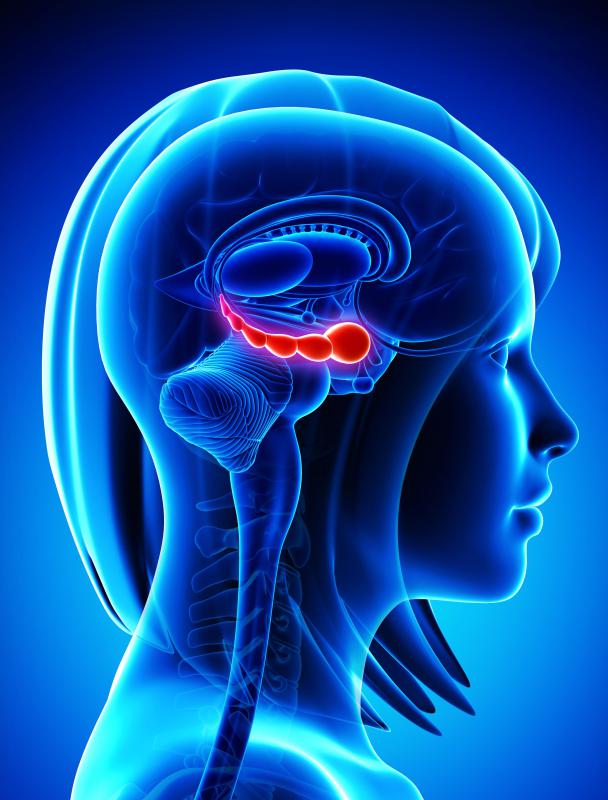At WiseGEEK, we're committed to delivering accurate, trustworthy information. Our expert-authored content is rigorously fact-checked and sourced from credible authorities. Discover how we uphold the highest standards in providing you with reliable knowledge.
What Is the Papez Circuit?
The Papez circuit, also sometimes known as the “medical limbic circuit,” is a pathway of the limbic system of the brain. It helps the cerebral cortex control emotions and also aids in memory retention. Understanding how brain circuitry works can be somewhat challenging, but an analogy to electrical circuitry can be apt, at least to an extent; the circuits are basically the pathways through which currents and energy flow. They contain and direct signals, and are usually designed for specific sorts of signals, too. In the limbic system, the circuits are highly specialized and work to help deliver chemical signals to and from the brain’s primary processing centers. The Papez circuit is one of the largest, and is primarily responsible for interpreting and identifying feelings, particularly those associated with memories.
Limbic System Basics

Human brains are highly complex organs. What may look like little more than fleshy gray matter to the untrained eye actually contains numerous specialized regions, pathways, and processing centers. The limbic system is an interconnected system of lobes, glands, and circuitry that brings sensation and chemical signaling from the lower and central part of the brain, primarily the thalamus and hippocampus, up to the cerebrum. It has a number of roles, but processing emotion and behavioral response are some of the most important; long-term memory and some smell recognition is also located here.
Main Function

Like most of the brain’s circuits, the main role of the medical limbic circuit is to process and channel information — in this case information related to emotional responses and memory formation. It carries information through the cortex as it processes emotions and memories and works to store them for easy recalling ability. The circuit gets its name from James Papez, a neuroanatomist who first identified it in the course of a 1937 experiment he conducted studying the effects of rabies introduced to the hippocampus of a cat. He noted that the circuit was made up of several smaller areas of the cerebral cortex.
Information Sharing and Signal Sending

The specifics of the relay itself are quite detailed. Basically, information is sent throughout the Papez circuit to sections in the brain starting at the hippocampal formation, which contains the fornix and other parts, and from there it goes on to the mammillary bodies. At this point, the information travels to the mammillothalamic tract and on to the anterior thalamic nucleus. The internal capsule to the cingulate gyrus is next along the path.

After the cingulate gyrus, information continues to the cingulum and parahippocampal gyrus, then to the entorhinal cortex and perforant pathway. Each of these is a distinct part of the limbic center. The final stop on the circuit is the hippocampus itself, one of the brain’s most important emotional and memory processing centers. From start to finish, information travels through 12 section. Neuroanatomy researchers have suggested that the septum, amygdala, and prefrontal cortex are also part of this circuit. It’s also commonly thought that the amygdala plays as large of a part in the circuitry signaling as hippocampus, if not slightly more.
Normal Variation

The more researchers study and learn about the human brain, the more it becomes clear that there are can be some pretty big variations when it comes to what is “normal.” Variations from person to person in this circuitry are no exception. Even with slightly different processing or patterning, though, most neuroanatomists agree that the function remains the same. The only real argument is about how all of the parts fit in along the circuit's path.
Consequences of Damage
Damage or scarring to any one of the stops through the circuit can cause problems with function as a whole, both within the pathway and on outside areas of the brain. If the amygdala is damaged, for instance, a person may have problems with responses to fear. Some people with hippocampal damage may have irregular or inhibited aggression responses. Anterior thalamic nuclei damage can cause spontaneous outbursts of emotion, such as crying or laughing at odd times. People with lesions that affect the entorhinal cortex do not have normal interactions between the neocortex and the hippocampus.
Not all damage is the same, and some people heal differently and more fully than others. There are still many unanswered questions and much that is unknown about how the human brain can function. Continuous research keeps providing doctors and patients with new information about how emotions, memories, and responses are carried and stored in the brain. It is largely decided that this circuit is an important part, but whether it is definitive when it comes to things like memory retention is harder to answer.
AS FEATURED ON:
AS FEATURED ON:















Discuss this Article
Post your comments